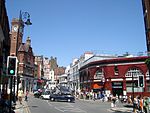Fenton House, Hampstead
Grade I listed buildings in the London Borough of CamdenGrade I listed houses in LondonGrade I listed museum buildingsHistoric house museums in LondonHouses completed in the 17th century ... and 7 more
Houses in HampsteadMuseums in the London Borough of CamdenMusic museums in the United KingdomMusical instrument museums in the United KingdomNational Trust properties in LondonOrchardsUse British English from August 2015

Fenton House is a 17th-century merchant's house in Hampstead in North London which belongs to the National Trust, bequeathed to them in 1952 by Lady Binning, its last owner and resident. It is a detached house with a walled garden, which is large by London standards, and features a sunken garden, an orchard and a kitchen garden.
Excerpt from the Wikipedia article Fenton House, Hampstead (License: CC BY-SA 3.0, Authors, Images).Fenton House, Hampstead
Hampstead Grove, London West Hampstead (London Borough of Camden)
Geographical coordinates (GPS) Address External links Nearby Places Show on map
Geographical coordinates (GPS)
| Latitude | Longitude |
|---|---|
| N 51.558891666667 ° | E -0.17968055555556 ° |
Address
Fenton House
Hampstead Grove
NW3 6SP London, West Hampstead (London Borough of Camden)
England, United Kingdom
Open on Google Maps










